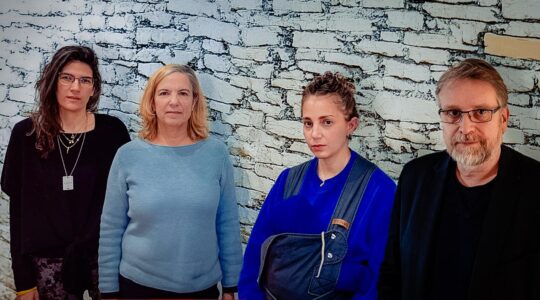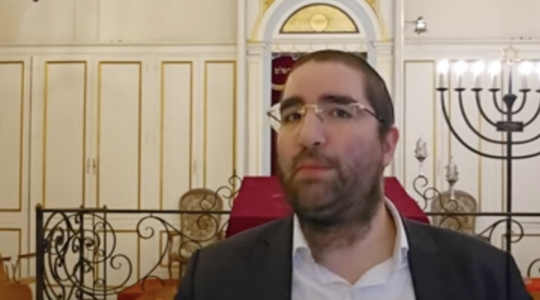LVIV, Ukraine (JTA) — The more I thought about it, the more it began to seem like a reasonable choice: I would roam around Europe for six months, visiting Jewish museums, talking to youth groups and covering various community happenings. I would travel from vibrant London to the post-Communist countries of the Eastern Bloc. But I would decisively avoid any intersection with my own family’s past.
Like many American Jews, my family history is deeply tangled in the tragedies of Jewish Europe. But I wasn’t going to engage with history on anything but an abstract level, through the detached eyes of a reporter.
That changed when I decided to pay a visit to western Ukraine. My family is from a shtetl called Shatsk, tucked into the far northwest corner of Ukraine’s Volynia province and a stone’s throw from the country’s borders with Belarus and Poland. In 1941, the young men of the village — including my grandfather and great-uncle — fled in the dead of night, convinced that the Germans would treat the village much as they did during World War I, when only men were targeted — for conscription.
This time around, the logic was that if the men were gone, what would the advancing soldiers want with a town full of women, children and the elderly? It was a miscalculation, and more than 1,000 Jews in the Shatsk area were shot into a mass grave by Black Lake, now part of one of Ukraine’s national parks.
For me and my family, Shatsk has always seemed like an impossibly exotic travel destination. I found it hard to believe that, as the Ukrainian census informed me, about 6,000 people lived there. Or that it had a nightclub called Sinatra and several ATMs.
But somehow, you can drive to Shatsk — and you don’t even need a souped-up DeLorean. After just four hours on roads whose quality varied from poor to middling to dear-God-is-this-a-road, my mother, our guide and I had traded the comparatively cosmopolitan Lviv — which was feverishly preparing for the 2012 European soccer championship — for the dusty roads of Shatsk, which lay dormant in the absence of summer’s rush of tourists.
The next day and a half was an emotional whirlwind.
A middle-aged Ukrainian couple — Tatiana and Stepan — let us into their home, which had been built in 1935 by my grandfather’s cousin and left unchanged in the decades since. We got the chance to step inside the tavern — now a branch of the Ukrainian national treasury — that my great-uncle ran and that elderly Shatsk residents assured us had been the social hotspot for the village.
We washed our faces in Black Lake and said the Shema. At the local Jewish cemetery, just four graves were legible and upright — and our family had connections to two of them.
There were the sharp, shooting pains of tragedy. I nearly buckled over and threw up when I realized that the slope the memorial to Shatsk’s murdered Jews sat on was not a landscaping feature but the mass grave itself. As lucky and honored as I was to be able to say the Mourner’s Kaddish and place a few stones on the memorial, there are some truths that even ritual can’t dull.
But there were also moments of triumph, like when we connected with the half-sister of my cousins who came to Brighton Beach in 1991. As we sat down to dinner with her and her family, swapped photographs and compared facial features (we all share the same eyes, it would seem), my mother and I felt blessed.
We had spent two days walking over what felt like hallowed ground — wondering if it was appropriate to take part in the regular rituals of travel, like toasting to our trip at a Shatsk bar, smiling in a photo or even admitting we were having a good time.
For 22 years, I had wondered what Shatsk meant for me. Was it a living, breathing place? Or just the graveyard of my family’s past? Was it some hell my family had escaped from? Or the bucolic paradise they spent decades in America pining after?
I’m aware of the challenges that come with heritage tourism. I spent 36 hours in Shatsk. Who is to say I’ve learned anything substantive about a place to which I parachute in, hunt around for some information and snap a few photos? How can I be sure that my newfound connection to Ukraine and my long-lost relatives is something more than fetishizing the past and longing for an idealized Shatsk that may have never existed?
But if heritage tourism is an imperfect science, it’s an important one. As a Jew in New York, it’s easy to lose sight of history — to view the past as a neat arc that started at Ellis Island, paused on a stoop in Brooklyn and triumphantly culminated in the green pastures of Westchester County or Long Island. If we consider the Old Country at all, it’s of a sanitized variety: Pop “Fiddler on the Roof” in the DVD player, rinse and repeat.
From visiting Shatsk, I know that my cousin Luba was tall and pretty with a good head for business. My great-uncle Chaim’s tavern was more popular than his competitor’s. For decades, the citizens of Shatsk have debated whether or not there’s some stockpile of gold hidden in the tavern’s basement.
My history has nuance now. Far more meaningful than the hazy memory of my 2002 bar mitzvah, my journey to the past, I’m convinced, has made me an adult in the eyes of Judaism and God.
Like Dorothy landing in Oz, my trip to Shatsk allowed me to finally view my family tree in Technicolor. I’m a better man for it.
JTA has documented Jewish history in real-time for over a century. Keep our journalism strong by joining us in supporting independent, award-winning reporting.





